Ping-Pong comes to SCDS
BY WILLIAM HOLZ
The Ping-Pong ball zips across the table as two la ser-focused high schoolers duel. The loud whacks and bounces of the ball are only outmatched by the gasps and cheers of the crowd.
The popularity of the newly added Ping-Pong table in the high school quad has grown exponentially. Students are al ways lined up for a turn to play during every free period and lunch.
Many find Ping-Pong a great way to pass empty time with friends, but some also believe it impacts students’ produc tivity. About a month into the school year, Table Tennis Club president junior Andrew Klieger decided to bring his favorite sport to school.
“I originally needed to do something with leadership for my college resume. So, in order to start the Table Tennis club, I bought the only thing the school was missing: a ta ble,” Klieger said.
However, the club was not an immediate success.
“In the beginning, a lot of people were skeptical, and no body really paid attention to it,” Klieger said.
However, these days you can find students in intense games at lunch, with a long line of people waiting their turns.
Many students, including juniors Annalucia King and club vice president Chase Usrey, have found playing PingPong a great way to make new friends.
“The Ping-Pong table is so much fun to play with friends,” King said. “I really love how it brings the grades together.”
CAMPUSCORNER
BLOOD DRIVE
The annual blood drive led by senior Jo nah David will take place Nov. 18 in the Benvenuti Gym. Students who are 16 re quire a parental consent form while those 17 and older are eligible to donate blood to the American Red Cross foundation. Contact David if interested.
Students hone their basketball skills in “The Lab”
BY SAHEB GULATI
Most mornings, as students drows ily file into Country Day, the sound of determined dribbling can be heard from the gym.
This is no ordinary basketball prac tice; it is The Lab, a community of dedicated high schoolers and pros working on their game.
Founded about 20 years ago by Country Day basketball coach Da vid Ancrum, The Lab has served as a



training ground for students to hone their skills against skilled profession als.
Ancrum played point guard profes sionally in the Continental Basketball Association and traveled internation ally to play in Greece, Panama, Ecua dor and Israel. After a knee injury in the late ’90s, Ancrum pivoted to high school coaching, leading him to Coun try Day.
Due to his years of international ex perience, Ancrum knows that playing
with older, better people is a great way to improve.
“You get guys that play at a high level and they force you to play at a high level, too,” Ancrum said.

Everyone from former and current NBA or WNBA players, NBA coaches, college players and overseas pros fre quent The Lab.
Country Day players appreciate the skilled competition they find there.
Students to attend national diversity conference
BY GARRETT XU
For the past two years, from 9 a.m. to 3 p.m. for a whole week, Country Day students attended the national Student Diversity Leadership Con ference by zooming in from the Mat thew’s Library due to COVID-19 re strictions.
But this year, it is going to be dif ferent.
Sophomore Saheb Gulati, junior Lauren Lu and seniors Simone DeBer ry and Karabelo Bowsky are excited to
attend their first in-person Student Diversity Leadership Conference in San Antonio, Texas, from Nov. 30 to Dec. 3.
The four high school students will be accompanied by Head of the Lan guage Department Patricia Portillo and Head of Lower School Maisae Af four, who will both attend the People of Color Conference, the adult version of SDLC.
At the SDLC, students of all races, cultures, social economic backgrounds and walks of life gather together to
focus on the topics of identity, self-re flection, belonging and community through presentations from social justice leaders, workshops and peer discussions.
For many, SDLC is a place for self discovery and belonging as they build bonds and strengthen a sense of com munity within affinity groups.
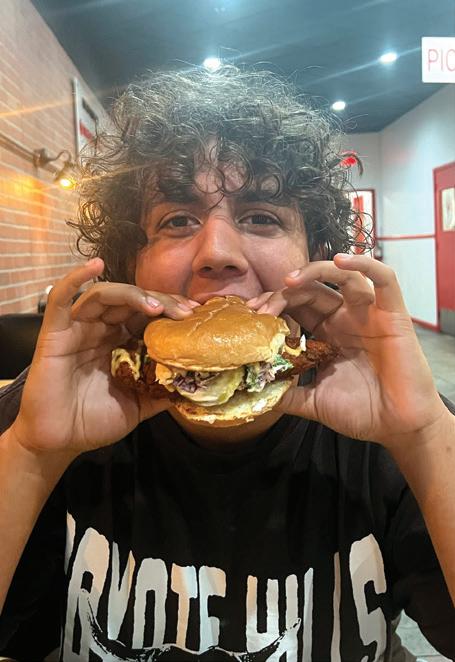
For others, SDLC is a place to de velop leadership skills and effective strategies for implementing social
THANKSGIVING BREAK
From Nov. 21-25, there will be no school because of Thanksgiving break. Whether that means catching up with extra sleep or hanging out with friends and family, it is holiday season, and it is time to be thank ful.
Chand’s Chicken Check-In No matter how you like your chicken, read about Chand’s chicken chow down for advice on where to go. (PAGE 10)
PHOTO COURTESY OF JACOB CHAND
VOL.46 NO.3 • Sacramento Country Day School •
Latham Drive,
•www.scdsoctagon.com • November 16, 2022 Non-Profit Organization U.S. POSTAGE PAID Sacramento, CA Permit No. 1668
@scdsoctagon THE
SET FOR NEXT TIME Junior Kaitlyn Diaz bumps the ball for junior Zoe Genetos as sophomore Cara Shin watches. The Girls Varsity Volleyball lost to Redding Christian on Nov. 9, ending their season. Story on page 6. PHOTO BY ADAM AKINS
2636
Sacramento, CA
OCTAGON
BASKETBALL page 3 >> PING-PONG page 3 >>
SDLC page 3 >> REVIEW
PRINT EDITORS-IN-CHIEF
Simone DeBerry
Garman Xu
ONLINE EDITORS-IN-CHIEF
Adam Akins
Samhita Kumar
NEWS EDITOR
Ishaan Sekhon
FEATURE EDITOR Ava Eberhart
SPORTS EDITOR Jacob Chand
A&E/OPINION EDITOR William Holz
PHOTO EDITOR Adam Akins
PAGE EDITORS
Andrew Burr
Jacob Chand
Emily Cook
Simone DeBerry
Ava Eberhart
Saheb Gulati William Holz Lauren Lu Ishaan Sekhon Garman Xu Garrett Xu

BUSINESS STAFF
William Holz, manager Aaryan Gandhi Saheb Gulati, assistant Garrett Xu
SOCIAL MEDIA STAFF
Samhita Kumar, editor
Ava Eberhart, assistant Lauren Lu
REPORTERS
Rehan Afzal Siri Atluri Eesha Dhawan Aaryan Gandhi Daniel Holz Irene Jung Sophia Monasa Anisha Mondal Anika Nadgauda Zema Nasirov Ryan Xu
PHOTOGRAPHERS
Rehan Afzal
Adam Akins Simone DeBerry Anika Nadgauda Zema Nasirov
MULTIMEDIA STAFF
Garman Xu, editor
Jacob Chand Simone DeBerry Ava Eberhart Irene Jung
GRAPHIC ARTISTS
Brynne Barnard-Bahn Lauren Lu Garman Xu
ADVISER Bonnie Stewart
The Octagon is the student-run news paper of Sacramento Country Day high school. The print edition is published eight times a year, and the website is updated daily. The Octagon is com mitted to unbiased and comprehen sive reporting, serving as a source of reliable information for SCDS students and the school community. The Octa gon will publish all timely and relevant news deemed appropriate by the ed itors-in-chief and adviser. We seek to highlight high-school-related events and spotlight the voices of those with a story to share. Further policies can be found on our website or by scanning the QR code below.
Killing in Purdue dorm impacts SCDS alumni
 BY EESHA DHAWAN & SOPHIA MONASA
BY EESHA DHAWAN & SOPHIA MONASA
Two Country Day graduates, Ethan Monasa, ’22, and Arijit Trivedi, ’22, recently started their freshman year as roommates in McCutcheon Hall at Purdue University.
Classes had only been in session for sev en weeks, and everything was going well, until the early morning of Oct. 5.
Monasa was having a conversation with his friend and a resident assistant, and Trivedi had just returned from the gym. At one point during their conversation, they heard sirens outside.
“My RA commented on it. He was like, ‘I hope that’s not for our dorm,’” Monasa said.
At the time, they did not think much of it, so no one left the dorm to see what might have happened. Usually, when si rens sound, someone is intoxicated, Mona sa said, but that was not the case this time.
According to the affidavit of probable cause filed in Tippecanoe County Court in Indiana, the sirens were in response to a 911 call from a male student who said he had just killed his roommate with a knife.
Police officers responded, arriving at Mc Cutcheon Hall to find the caller, Ji Min Sha, still in his room. He had what appeared to be blood on his clothing and body. Officers found Sha’s roommate, Varun Manish Ch heda, 20, sitting in his chair. Medics arrived and confirmed Chheda was dead, accord ing to the affidavit.
Sha, 22, was charged with murder.
When Monasa and Trivedi found out what happened later that morning, they were shocked.
“It was all just kind of very sudden. Peo ple didn’t really know the details of what was going on,” Monasa said.
Around 8 a.m. that day, 7 hours after the incident, Purdue President Mitch Elias
Daniels Jr. sent out an email informing the community about what had happened.
“I write to let you know that early this morning, one of our students was killed in his residence hall room,” Daniels wrote.
Daniels assured families that the safe ty and security of Purdue’s students re mained the No.1 priority.
“This is as tragic an event as we can imagine happening on our campus and our hearts and thoughts go out to all of those affected by this terrible event,” Daniels said in the email.
In Trivedi’s first class that day, commu nications, no one said anything about the incident, but his psychology professor can celed class later that day.
Some professors sent out emails to stu dents making sure people knew how to ac cess various mental health resources.
Everyone on campus seemed slightly on edge for the first 48 hours after hearing about the incident, Monasa said.
“You’d hear people talking about it in their own groups, and you could just tell people were a little uneasy,” Monasa said.
Many people were glued to their phones trying to look for news or spreading any in formation they could, Trivedi said.
There has been a memorial set up on campus at the Unfinished Block P emblem. Monasa and Trivedi have both seen the memorial but did not attend the vigils.
The campus has calmed down since the incident, Monasa said.
Monasa and Trivedi live in the North Tower of McCutcheon Hall, and the inci dent occurred in the South Tower of the hall.
“It’s shocking to have a crime as severe as a homicide happening in your house that you’re living in,” Trivedi said.
These kinds of crimes happen all over the place all the time, Monasa said.
“When it’s in your dorm, in the same building you live in, then that definitely is a little unsettling. It does catch you off
guard and makes you think about it more,” Monasa said.
The news of the tragedy quickly reached Brooke Wells, Country Day’s head of high school.
“Once I found out, I was obviously wor ried,” Wells said.
He contacted the Monasa and Trivedi families, ensuring the students were okay and offering support.
Ji Min Sha’s criminal case is pending in Tippecanoe Circuit Court in Indiana. A hearing has been set for Dec. 2.
Editor’s Note: Reporter Sophia Monasa is the sister of Purdue student Ethan Monasa.
This story was originally published in the online edition of The Octagon on Nov. 9. 2022.
ISSUE 2 CORRECTIONS
It is The Octagon’s policy to correct factual errors
octagon@scdsstudent.org
Page 1 “Testing in a test optional age:” The University of California and the California State Universi ty systems no longer consider the SAT and ACT test scores during the admission process, meaning they are test blind. However, after a stu dent is accepted, the two university systems may use the two tests to determine a student’s course place ments.
Page 5 “High school trips return:” The location of the freshman trip was incorrect. The correct location is Forest Suites Resort in South Lake Tahoe.
02 NEWS NOVEMBER 16, 2022 • THE OCTAGON
STAFF
IN LOVING MEMORY People leave kind notes and bouquets of flowers at the Purdue University memorial for Var un Manish Chheda, the student who was killed in his dorm on Oct. 5. PHOTO BY SOPHIA MONASA
and to clarify potentially confusing statements. Email us:
Ping-Pong: Table tennis is good for stress but can be disruptive to others in quad
from page 1)
Usrey, one of the first to play, noted that the table has become a central part of the community. “Playing with friends is the best,” Usrey said. “You’re able to compete casually or competitively, and you’re able to grow with your friends along the way.”
Sophomore Cezar Abou Zaki has also reaped benefits from the table. Instead of scrolling through social media during his free time, Abou Zaki now opts to stay ac tive and connect with others during that time.
“It’s a great conversation starter for peo ple I haven’t spoken to in a while,” Abou Zaki said.
However, some people on campus have concerns about the table’s impact on stu dent productivity.
“Based on what I’ve seen, the Ping-Pong table has brought many people together,” computer science teacher Charles Far ris said. “But, it does seem like it could be distracting to others trying to work in the area, as it’s placed in the middle of the high-school quad.”

To alleviate the problem, Farris has con sidered relocating the table behind the gym next to the shipping containers, but a
lack of supervision in that area makes that alternative problematic.
Junior Delsyn Beaton expressed the same concern.
“I can understand how distracting it can get,” he said. “People get so excited between points, and it can get loud some times. I’ve experienced this first hand, and I always have to move out of the quad to focus somewhere else.”
With her room the closest to the table, English teacher Jane Bauman often strug gles to concentrate with the sound level.
“Sometimes kids get noisy, but they al ways quiet down when I ask,” Bauman said.

And, despite the volume, Bauman appre ciates this new addition to the community.
“I like the way it galvanizes students. It’s cool to see everyone playing and watch ing,” she said.
In response to this problem, Klieger says he will make sure to manage sound levels, reducing the amount of interference with classes.
“But, don’t be too quick to hate on PingPong,” Klieger said. “It fosters friendly competition between students and is a great way to de-stress or take your mind off of academic pressures.”
Basketball: ”The Lab” pushes players’ game to new heights
(continued from page 1)
“It’s just eye-opening to see what other people are capable of,” said senior point guard Felix Wu.
Ancrum welcomes this addition of talent and the benefits it can bring for students.
“We don’t know it all. That’s why a lot of Kings players come in, and I trust them,” he said. “We’re all just trying to get better at the end of the day.”
This influx of talented players has led to some changes in how The Lab functions.
Doug Christie, a former Sacramento Kings player and current Kings assistant coach, brought in the idea of concepts: forcing players to utilize tools like the pick and roll, dribble handoff, post passes or cut and pick away before scoring.
The Lab, however, is not open to every one, Ancrum said. He only allows outside players who are both dedicated and able to
help Country Day players improve.
When Lab-goers request to bring in someone to the gym, Ancrum said he asks two questions:
Is the person nice?
Does the person like basketball or love basketball?
One of the more recent additions to The Lab’s community is Justin Garcia, a basket ball player at San Joaquin Delta College.
Garcia was referred to The Lab around six months ago and has not looked back.
“I love it,” Garcia said. “The way every one is serious, and the way Anc runs it.”
Thanks to The Lab, he has seen marked improvements in his shot.
The next step for Garcia? Wherever he can get his foot through the door, be it the G League (NBA development league), NBA or overseas.
“It’s been going good so far, working with pro guys, staying in the gym every day,” Garcia said. “I’m getting close.”
Because players like Garcia only enter The Lab by invitation, it remains a close community, Ancrum said.
“That’s the secret. If you bring in some one, you’ll be accountable.”
This model has worked, making The Lab “the place to be” for serious players.
For Country Day players, this also means they have a safe environment to improve
their game with people at a high level — and improve they have.
Senior RJ Vargo has attended The Lab since fifth grade, and has developed essen tial skills he has used throughout his time at Country Day.
He first started ramping up his lab atten dance after being encouraged by Ancrum in seventh grade.
“Being able to dribble under pressure, shoot under pressure and make free throws is all stuff The Lab teaches you,” he said.
people accountable because that’s how you get better.”
Everyone plays under the same rules. People have to play hard, come early, make their free throws and keep their heads up on the dribble, he said.
Vargo enjoys this aspect of The Lab.
“It doesn’t matter who you are, you gotta respect the gym and the game. There are no shortcuts,” Vargo said.
Ancrum is thankful to the many great coaches and players who come to The Lab and help players get better: people like Christie, Lakers assistant coach Chris Jent, former Princeton coach Pete Carril and Ruthie Bolton, an Olympic medalist and former WNBA player.
“It takes a village to raise a child, and I don’t know it all. Whatever they can do to help kids get better, I’m all for it,” Ancrum said.
Often, when people come to The Lab af ter being absent for a while, one of the first things they note is how much Country Day players have improved — one of Ancrum’s favorite parts of The Lab.
Wu credits The Lab for improving his basketball IQ and helping his work ethic.
Ancrum cultivates this by making sure people are held accountable and able to take criticism.
“No excuses,” Ancrum said. “We hold
The Lab will continue as long as Country Day kids want to continue getting better, Ancrum said.
“That’s why it started in the first place,” he said. “Anyone else who wants to work on their game, we get them to work as well.”
SDLC: Students to explore identity in Texas
(continued from page 1)
justice ideas and practices to better the community socially on a local and global level.
“SDLC is really just this place where you get to learn a lot about yourself and the commu nities you feel you belong to,” Bowsky said. “It’s really a time of fostering inner confidence in who you are as a person and, in the meantime, you learn tools on how to be a better leader in your community.”
Bowsky, who is Black, was adopted into a white family. She said SDLC was especially meaningful to her in the sense that she could really explore her identity.
“Just being able to learn about parts of myself that I didn’t even think twice about and knowing that hundreds of millions of people share some thing similar to me, it really just feels good knowing I’m part of a group,” she said.
However Bowsky does not want to just stop there; she
wants to help others and make a positive difference along the way.
“Knowing that so many peo ple probably feel just as isolat ed and as lonely, I like to know there’s room to help other peo ple and make a positive impact within the community,” she said.
The SDLC has already im pacted Country Day.
Two years ago, Kenyatta Du misani, ’21, founded the Justice, Equity, Diversity and Inclusivi ty Council — JEDI council for short— at Country Day after attending SDLC.
DeBerry now runs the coun cil, continuing the legacy of the group.
The student-led council cre ates a safe space for students to comfortably share any person al experiences or issues they had with the school’s dynamics that they would otherwise not be comfortable sharing with a faculty member.
Portillo, the adviser of the council, stressed the impor
tance of having that space to process personal struggles.
Many students go through painful experiences they do not know how to properly and emotionally deal with alone, like being a target of microag gressions or even degenerative racism, Portillo said.
“It’s difficult sometimes,” she said. “So, having a space to think about it, process it and to understand that there are peo ple who care and want to sup port you, it just opens up your mind. It’s life changing, and it helps them to get past that and be stronger.”
SDLC provides just that.
“The students that went to SDLC went from being in these affinity groups and workshops to forming these clubs, ” said Jo Melinson, high school librar ian and active member of the Identity, Diversity, Equity and Activities committee.
“That’s what leaders do. They see good ideas and they want to share them with others.”
But, for this year’s student
leaders, there’s another great reason to anticipate the con ference.
In her years attending SDLC, Bowsky has made lifelong friends, many of whom she still talks to frequently on a group chat. She described it as a sup port system based on mutual understanding where everyone helps each other through their problems.
“All I want to say is I’m so ex cited for them because I think that it’s gonna be such a life changing experience for each one of them,” Melinson said.
Gulati and Bowsky are both returning attendees while De Berry and Lu are both newcom ers.
“It’s an experience you won’t have anywhere else,” Bowsky said. “It’s a really good thing to do especially in high school be cause it can really expand your mindset and really teach you a lot about not only your com munity, but about yourself.”
“I’m really excited,” Lu said.
(continued
SERVE AND SWERVE Sophomore Max Weitzman plays an intense game of Ping-Pong in the High School quad. In recent months, Ping-Pong has be come a popular pastime for many students. PHOTO BY SIMONE DEBERRY
No excuses. We hold people accountable because that’s how you get better.”
DAVID ANCRUM A BIG THANK YOU TO OUR SPONSORS! Akins family, Chand family, DeBerry family, Intel Foundation, Kumar family, Monasa family and Xu family
“ NEWS 03 NOVEMBER 16, 2022 • THE OCTAGON
When senior Savanna Karmue was 6 years old, she visited a hospital to check on her Sun day school teacher who had recently undergone heart surgery. She met some of the cardiologists who were treat ing her teacher, and it sparked a profound interest in the heart.
One day, she found out that over 2,000 people in the United States die from heart disease daily.
“That just kind of broke my heart, and I was like, ‘why are peo ple dying from an or gan that does so much to keep us alive?’” Kar mue said.
It was then that she realized she wanted to be come a cardiologist so that she could help hearts do what they are supposed to do: keep peo ple alive.
However, she knew it would be many years until she could become a cardiolo gist, and Karmue did not want to wait.
So, on her eighth birthday, which also happens to be Valentine’s Day, she found ed her non-profit organization, Happy Heart Advice.
For the past eight years, as the CEO of the non-profit organization, she has been educating communities, es
“I realized that if I want to teach people about the heart and how to keep it healthy, I want to make sure they actually under stand it,” she said. “That comes from youth first because I believe if we impact people at a very early stage in their lives, then we can have them form better habits.”

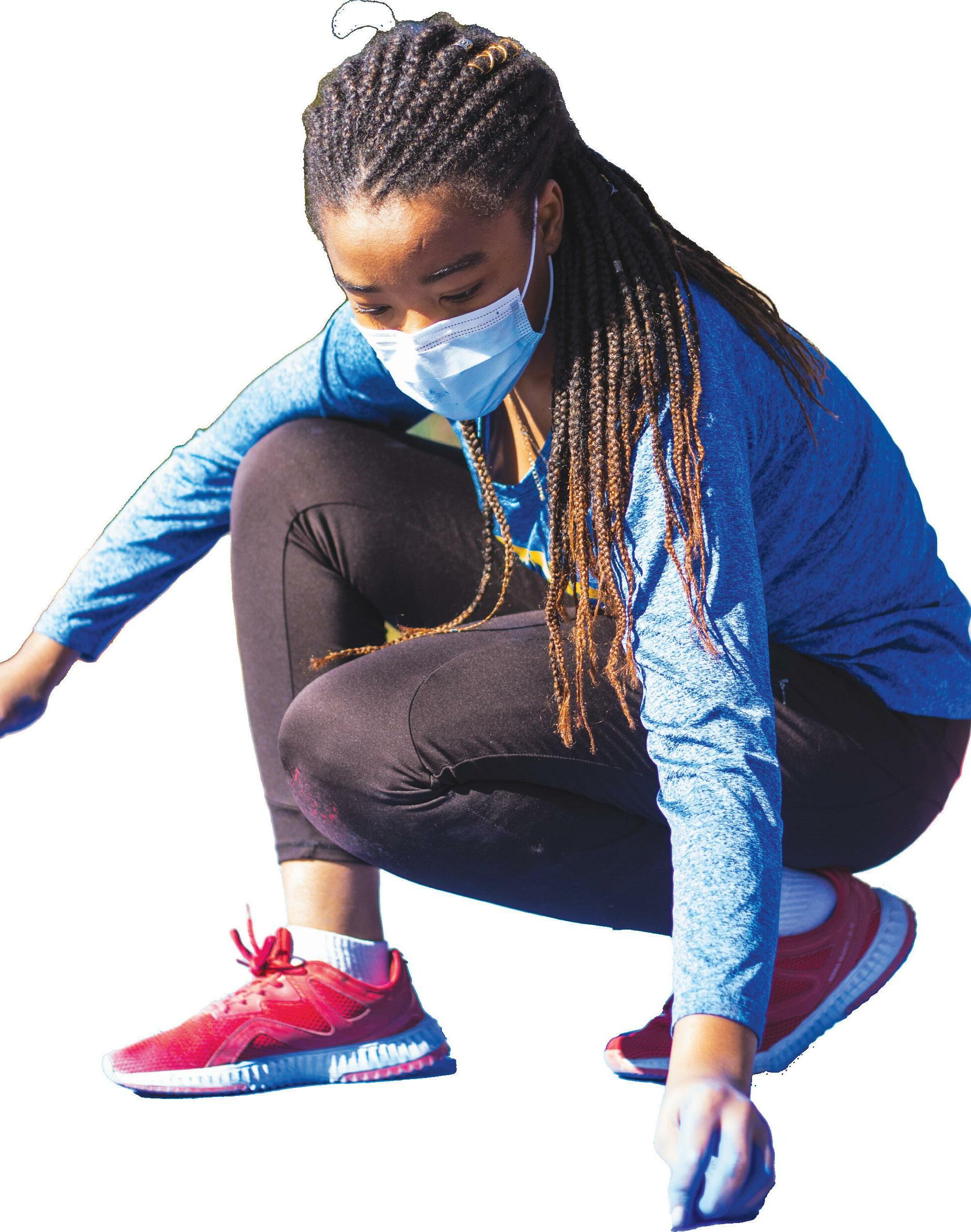





Although the book was written for young children, it is sophisticated enough for all ages.

“And then, it just pro gressed into further pro grams that I created,” she said.
However, her road to success has not come easily.
When she was younger, she had to deal with a speaking disability, in which she had trouble pronouncing some letters.
“I was a very shy speaker, and I didn’t speak out a lot,” Karmue said.
Despite this, she knew that she needed her voice to speak out about her passion, so she worked to overcome it.
“That was one of the major hurdles and roadblocks. Every once in a while, it will pop up nowadays, but it’s not as frequent as before,” she said.
In addition, Karmue has made many sac rifices to work toward her goal.
scenes. That means sacrificing sleep and all these other things in order to get to where I want to go,” she said.
Sometimes, Karmue has to give up hanging out with friends to work on her organization, but she knows it’ll be worth it, she said.
Although it varies based on what she has to do, Karmue usual ly spends an average of 15 hours a week working on her orga nization.
“There’s just so much that needs to be done,” she said. “We’re trying to find grants for low-income schools because they aren’t able to afford the program, and I have meetings with the principals.”
Not only does Karmue tend to her orga nization outside of school, she also runs the Happy Heart Volunteer Club at Coun try Day, which she started last year.
The club allows high school students to gain volunteer hours by helping Karmue with her non-profit.
“Happy Heart can’t be a one-person team,” she said. “My club really focuses on getting Country Day students to help me run my program and to teach other ele mentary schoolers about the heart.”
Senior Shakhzoda Khodjakhonova, the
graders learned about the heart and how to keep it healthy.

“On a day-to-day basis, we would use my book in the curriculum,” Kar mue said. “We would take a chapter from the book and then we would do activi ties correlating with that chap ter.”
On the first day, the club taught the kids about what the heart is. Then, they created a chalk mural of the heart and the kids moved over the mural as if they were blood cells moving through the heart.
Karmue’s goal for the club is to have third, fourth and fifth graders at Country Day participate in a week-long program.
“I want it to be even bigger than last year, and hopefully more fun because we have more people and more ideas,” she said. “I want to try and get my Happy Heart program into all elementary schools in the United States.”
Karmue has already made significant progress with her goal through an intern ship she is doing with biology teacher Kel lie Whited.
“We already have three schools in the area that we’re bring ing the curriculum to, and Savanna wants to add seven more,” Whited said.
With help from Whited, Karmue is fine-tuning and adapt ing her curriculum based on participating schools.
ed for five weeks and was for third grad ers at Country
Through the pro gram, third
“I think it’s incredible that someone her age is so driven and so goal-oriented,” Whited said. “She had this goal that started when she was 8 years old, and she’s still so passionate and has grown. Her curric ulum is turning into a life-long passion.”
In addition to the club, during COVID-19 quarantine, Karmue started up a podcast, Mental Mondays with Savanna, which piv ots to the topic of mental health.
“I picked Mondays because everyone hates Mondays, so my goal was to help make someone’s Monday a little bit bright er,” Karmue said.
Although Karmue’s main focus is typ ically physical health, she wanted to em phasize the significance of mental health just as much.
“During quarantine, I realized that even if a person is physically healthy, it doesn’t mean that they’re mentally healthy. It’s important to keep that balance,” she said.
In her podcasts, Karmue discusses self-improvement, mental wellness and lifestyle. Although the podcast is on a short hiatus due to the time-consuming process of completing college applications, Kar mue plans to start the podcast again soon.
Karmue’s ultimate goal for the future is to have an impact on kid’s lives and for them to get something from her programs. In addition, her passion to become a cardi ologist hasn’t faltered.
“I would consider Savanna to be a re lentless, patient and determined person,” Khodjakhonova said. “She’s someone who, once she sets her mind to something, will get it no matter what.”
04 FEATURE
NOVEMBER 16, 2022 • THE OCTAGON Senior Savanna Karmue hopes to help future generations keep their hearts happy HAPPY HEART ADVICE 2017 23 million kids obese 2031 reduce child obesity by half
savanna karmue
STORY BY AVA EBERHART; GRAPHICS BY LAUREN LU; PHOTO BY ADAM AKINS; DATA FROM HAPPY HEART ADVICE WEBSITE
Senior suffers from injury, returns stronger than ever
BY SIRI ATLURI
Senior CJ Dwumfuoh began his fit ness journey at the end of his fresh man year.
An athlete his entire life, Dwum fuoh was driven to improve, which eventu ally evolved into a passion for training and weightlifting.
“I discovered that you can actually train your body in certain ways to become a bet ter athlete, and that inspired me to pursue weightlifting. As I’m finishing up my sports career, I’ve decided to kind of get into bodybuilding,” Dwumfuoh said.
At Country Day, Dwumfuoh has been a part of many teams.
During his freshman and senior years, he played soccer. As an underclassman, he played basketball, but neither was his true calling.
“My main sport is track and field, and that’s what really got me into my training, just because I wanted to learn how to run faster and jump higher,” he said.
Dwumfuoh competed in the 100 meter, 200 meter, and long jump events.
However, all of that came to a premature end when he experienced a major setback during his junior year.
“I was just playing basketball casually, and my knee twisted a little bit,” he said, “It was pretty bad. I couldn’t really walk properly, so I had to go to the hospital.”
After a few X-rays, Dwumfuoh learned that he had torn his meniscus and needed surgery.
“That devastated me,” Dwumfuoh said, “because I was training for that upcoming track season.”
Senior Tonye Jack could see first hand how Dwumfuoh’s injury affected him.
“I met CJ back in preschool,” he said. “He’s like a brother to me.”
Over the years, Jack has seen how Dwumfuoh matured and how his attitude changed towards sports.
“I’d say he’s learned a lot more about himself and his own interests and what drives him,” Jack said. “He’s very adamant on growing and becoming a better person.”
Jack commends Dwumfuoh’s growth
mindsent for constant improvment.
“He’s very adamant about working out,” Jack said, “and he couldn’t run track; he couldn’t do his sports. But, he bounced back from it really well. This year, he’s doing everything he can. He’s still doing track; he still did soccer. He didn’t let it stop him.”
Although the injury was a major set back, it also reshaped the way Dwumfuoh thought about athletics and training.
“Through my physical therapy, I really got into getting my legs stronger, improv ing my balance and learning from my mis takes,” Dwumfuoh said.
His mistake? Training rigorously without focusing properly on recovery and safety components like warm-ups and stretching.
Dwumfuoh’s injury taught him the im portance of training safely and properly. This, combined with his original passion for training, inspired Dwumfuoh to start a weightlifting club at Country Day, an activ ity he began during track and field.
“Most of it is weightlifting,” Dwumfuoh said, “and then the rest is kind of running. It’s all explosive movements. I loved work ing on my foundation, which was my jump ing and spring ability, explosion from a very diverse or very short amount of space.”
When the school weight room reopened after the pandemic, Dwumfuoh noticed that a lot of students showed interest in working out, so he founded the Weightlift ing Club.
“I thought, well, let’s take advantage of this; let’s make this a new organization to teach people about fitness,” he said.
As club president, Dwumfuoh plans to discuss injury recovery.
He learned the importance of taking care of his body after his own injury, and now, his fitness journey includes teaching his club members how to take care of them selves properly so they do not suffer the same physical setbacks he did.
“That happened to me,” Dwumfuoh said. “I don’t want that to happen to other peo ple.”
Jack respects Dwumfuoh for his commit ment to others and says he deeply values the bond they share.
REHAB AND RESTART Senior CJ Dwumfuoh works his way back to the weight room after a 6-month break caused by a torn meniscus. Today, he heads Country Day’s Weighlfiting Club as a means to motivate and educate other dedicated athletes. PHOTO ILLUSTRATION
“I think he’s a go-getter. If he doesn’t know something, he learns it, and after quarantine, seeing him be able to improve
BY SIMONE DEBERRY
himself and everything around him, like school, body and mind is really inspiration al,” Jack said.
Weightlifting Club creates community
BY SIRI ATLURI
During their free periods and af ter school, students in Country Day’s Weightlifting Club go to the weight room. Together, they cheer when their fellow members reach new personal lifting records.
Senior CJ Dwumfuoh founded Coun try Day’s Weightlifting Club — also known as the fitness club — in the middle of his junior year. He wanted to encourage students to begin their fit ness journey while educating them on the process.

For Dwumfuoh, community is a core component of the club.
“We have around 25 members. A lot of underclassmen are enthusiastic about this, and I love that,” Dwumfuoh said.
Senior Samrath Pannu did not have a private gym membership before join ing the club last year. Though it was not his first experience working out, he found lifting at school with his friends

to be much more enjoyable.
“I joined because my guys joined, and I felt like I should lift with my guys,” he said.
During club meetings, Dwumfuoh has members focus on nutrition and performance as part of his vision to expand club focus to include overall health.
“My main goal for this year is to get another field trip organized,” Dwum fuoh said. “I am trying to do one every quarter.”
Last year, the Weightlifting Club went on two field trips to Fitness Rangers and Results Transformation Center, gyms in the Sacramento area.
At both gyms, they talked to the owners who taught the members how to train properly.
Part of the club’s appeal is also its relaxed, low pressure environment.
“It’s very relaxed,” Dwumfuoh said. “We don’t have official meetings a lot. People just go in and lift.”
Senior Jonah David appreciates this relaxed feel.
“It’s a way to hang out when you’re working out,” David said. “I just go spontaneously. I don’t really have a set schedule, but I guess that’s another benefit of it.”
Before new members can join, they must go to gym teacher Michelle Myers for a debrief, where she teaches them how to use the different machines.
According to Dwumfuoh, the bench press, chest fly, lat pull down and ca prese machines are especially popular.
Members of the fitness club have already seen personal improvement while working out.
When Pannu started his fitness journey alone, he was barely able to do three pull ups.
“Now, I can do about fifteen,” he said.
Anyone interested in joining the club, can contact Dwumfuoh, Myers or senior RJ Vargo to schedule an orien tation.
Students in fitness club have the op tion to train during their free periods, lunch, elective one and after school.
SPORTS 05 NOVEMBER 16, 2022 • THE OCTAGON
PERSONALRECORDS BENCH PRESS: 205 LBS LAT PULL DOWNS: 180 LBS CHEST FLY: 250 LBS
KEEP FIGHTING
CAVALIERS

Varsity volleyball team ends league season by winning its semi-finals
BY ZEMA NASIROV & SOPHIA MONASA
Country Day’s girl’s varsity volleyball team ended the season by winning the league semi-finals 3-0, but losing section finals 0-3.
Although the team lost during section finals, this season was the third time ever that the varsity volleyball team has made it to cham pionships in Country Day history.
“We haven’t won a league since 2017-18, so I feel like this is one of the most complete teams we’ve had.” coach Jason Kreps said.
The team has seen a lot of growth throughout the season, with some play ers improving signifi cantly, Kreps said.
For the section play offs, the team faced the Sacramento Adventist Capitals and started off
the first set winning 25-6.
As far as how Kreps expected the game to go walking into the playoffs, he said that he was very confident with how much the team had been working, but going into the match would force the players to adjust in order to win the game.
The Cavaliers took the lead from the first set, but the Capitals began to make a come back during the second set.
“I knew they’d come back in the second game and we were behind for most of it,” Kreps said.
During that second set, Kreps called a timeout, allowing the team tore-evaluate the game ahead of them. Kreps pushed them to play smarter and faster on defense. And, the team responded accordingly, winning the second set as well.
Leading 2-0, the team kept up their game to win the final set. Improving from the previous set, the players on the court exhibited great communication, staying in
sync to finish the match and win the semifi nals, advancing to finals.
Still, despite the loss at finals, Kreps is proud of the team for the improvements they have made throughout the season.

“The girls play for each other, which is su per fun to watch. They just love the game,” he said.
Although the team intends to return next year, it will be without seniors Haylee Hol man, Sage Spradlin and Shakzoda Khojak nova.
“I’m really sad, but I’ve been at this school since pre-K so I feel like I’ll always have this place as a place to come back to,” Holman said.
However, Kreps is confident in the team’s future.
“I feel like we will still be super strong. Haylee will definitely be a hole to fill, but I feel like we have players ready to step into those positions” Kreps said.
SCDS XC team sets high hopes expectations for upcoming years
BY AARYAN GANDHI & GARMAN XU
Country Day’s cross-country team nears the finish line, qual ifying and competing in the Sec tion Championships. The team has grown, and Coach Joe Hart man believes that the team can reach the state level this year or in the coming years.
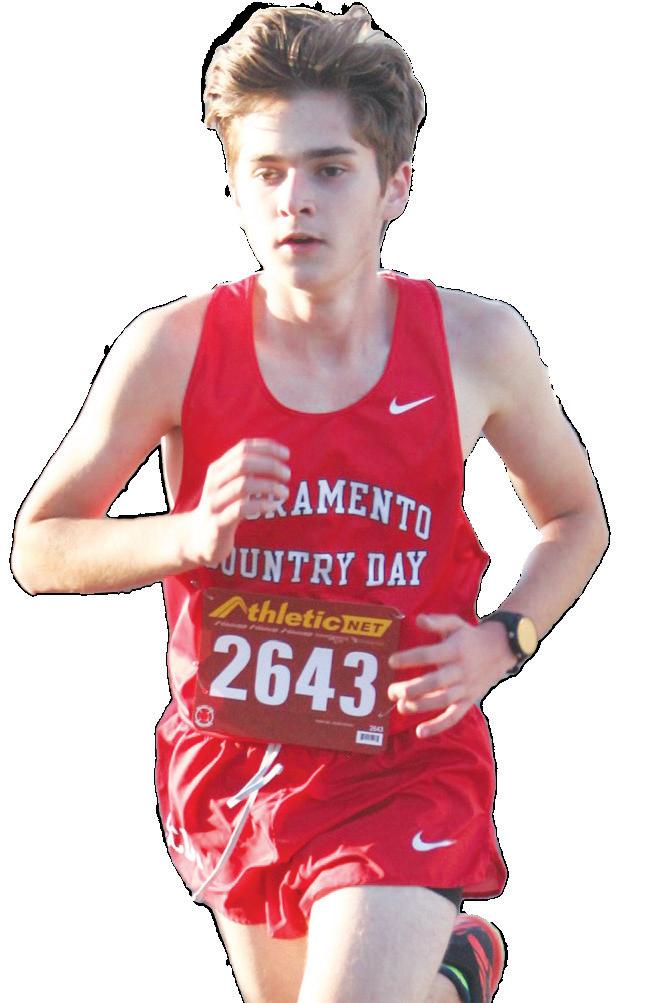
At the beginning of the sea son, Hartman’s goal was to place highly at the league champion ship and qualify for sections. Nonetheless, Hartman’s ultimate goal as a coach is to reach his team’s potential.
“My No. 1 goal as a coach is to grow the program and to just help the runners feel good about themselves and be the best they can be at running.” Hartman said.
Hartman worked with the run ners on developing effective and
manageable training schedules.
The team used multiple lo cations to practice in order to prepare for the different cours es they would encounter over the season. The team trained on campus, on the American River Trail and traveled to Ancil Hoff man Park to train for hills.
Hartman highlighted soph omore Wyatt Hall’s dedication to training over the summer. As a result of his efforts, Hall im proved his times significantly. Hall hit a personal record for the 5k with a time of 18:40.3 at the Clovis Invitational.
“I definitely got faster this season which feels great,” Hall said. “Going to the practices and meets helped me get better be cause it improved my strength and pace.”
In addition, Hartman struc tured individualized workouts for some runners.
“Since I’ve been busy with se nior stuff, he gives me my own workouts for the week,” Eberhart said. “When I’m practicing for a race, I usually do long-distance running for 5 to 6 miles or prac tice speed workouts.”
At the sub-sections meet, Eberhart set a 3-mile personal record with a time of 25:14.9 in girls’ varsity.
Highlights for the rest of the team included qualifying for the Nov. 12 section championship at Willow Hill Reservoir. A first and second-place finish from sophomore Andrew Burr and junior Aakash Arugam respec tively qualified them to com pete in the State championships. Additionally, freshman Maddie Inman finished first in the fresh man-sophomore girls race, and
CENTERPOINT 06 NOVEMBER 16, 2022 SEASON 2 22
WYATT HALL 5K PR
Senior Grace Eberhart trained with the team and independently to fit her packed schedule.
18:40
Cavs varsity boys soccer team finishes season placing fifth in league
BY ANIKA NADGAUDA
After a loss to Futures High School during playoff semi-finals, Country Day’s varsity soccer team ended the season as 5th in the Sac-Joaquin Section and 18th in the state for
The team ended the season with a positive record, winning 12 games, losing five games and tying two games.
Junior Derek Taylor saved 102 shots this season between the 17 games that he played.
Senior co-captain RJ Vargo scored 18 goals this season, sophomore Parker Byers scored 11 and senior co-captain Adam Akins scored
One game, in particular, made RJ especial ly proud. During a game against Western Si erra, Akins scored a goal in the first few min utes of the game. The team then proceeded to play strong defense ending with a 1-0 win.
A similar play occurred in the homecom ing game when RJ scored a goal only two minutes into the game.

After this year, however, the team will be very different, losing 10 players to gradu ation. But, RJ is confident that the younger members of the team will do quite well.
“I think they will be fine and make it to the playoffs and hopefully semi-finals next year,” RJ said.
To do this, Akins provides the team with some advice for their next season.
“We need to be able to allow players to work out of their comfort zones and have people learn new positions because we had 10 seniors on the team,” Akins said. “We’re going to have players learn a lot of new roles to be competitive next year.”
Head coach Matt Vargo hopes that the younger players will mature enough to be the leaders of the team, and RJ hopes that the team will be able to maintain the strong
bond they formed this year.
“We’re always trying to get excited during the game. I’ll look over at the bench and try to get everyone moving a little bit,” RJ said. “[Junior] Aiden Cooley is good at getting ev eryone hyped, and that is a big thing for our team”
Cooley, a new addition to the soccer team, played soccer for the first time this season. Cooley ended up scoring one goal and mak ing one assist. Senior Aaron Monasa felt proud since he made six goals this season, compared to the one goal he made last sea son.
Coach Vargo knows that next year with a loss of 16 players in the past two years the team dynamic will change a lot. But he has high hopes for the varsity soccer team and believes they can make it to the top three of their league next year.
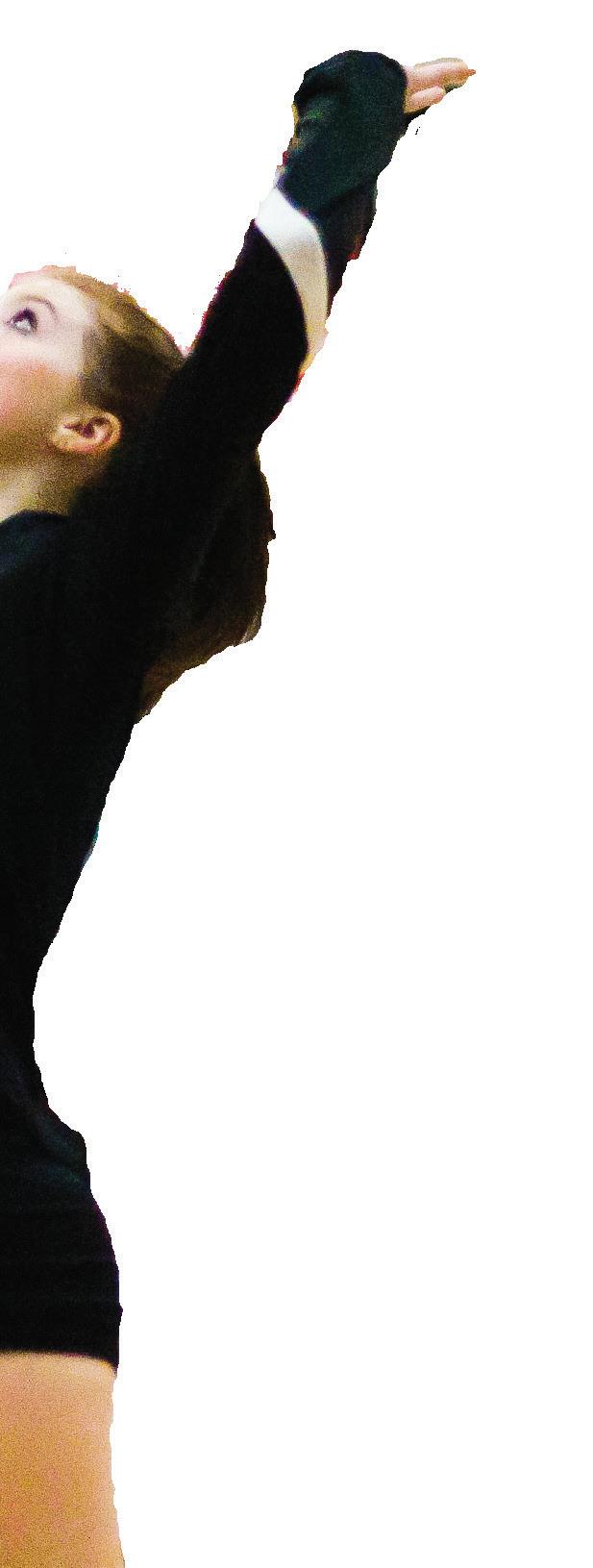

55
soccer goals scored
hopes and years
Eberhart made a PB of 26:20 for the 5k. Country Day placed 5th as an overall team.
However, as the season inches closer to the finish line, it also marks the end of Country Day cross-country for seniors Eber hart and Adam Akins.
“Grace has been on the team the most frequently and it is real ly going to be hard to lose some one of her cohesion, talent and attitude,” Hartman said. “Adam is just an amazing athlete that ran for us full-time in the past and part-time this year.”
Looking forward, the cross-country team hopes to qualify for the state finals next year. The last time Country Day made it to the state finals was in 2012. Hartman believes the team can achieve this goal through tal ent and hard work.
CENTERPOINT 07 THE OCTAGON
RECAP 22
-Soccer co-captain RJ Vargo “THE POSITIVE BENCH CULTURE MADE US INTO A SPORTS TEAM. WE WERE ALL FRIENDS WHO ENJOYED TO PLAY SOCCER WITH EACH OTHER”
Senior Amaya Anguiano entered Coun try Day high school fully expecting to be overlooked in the curriculum.
But, she wasn’t.
Here at Country Day, diversity has and should continue to be extended beyond the student body and into the curriculum.
Last year, when English teacher Jason Hi nojosa taught “There There,” a book written by and about Native Americans, with his Ad vanced Topics in English Literature class, a student approached him after class.
“He said that he had never read a book where it felt like someone like him had been featured in the book,” Hinojosa said.
Understandably, this saddened Hinojosa to hear. His bright, well-read senior had never seen himself in the literature he consumed, and it was only when he finally did that he began to embrace class discussions with new vigor.
“There’s something about seeing yourself in the stories that you read and the media that you consume that generates a genuine interest,” Hinojosa said. “If you don’t have that, it’s kind of hard to ask a student to care about a story that doesn’t relate to them.”
However, a diverse curriculum is about more than just student enjoyment—it’s a matter of confidence.
In a 2010 study conducted by Celestial Zal dana of Harvey Mudd University, evidence showed that members of minority groups who are traditionally underrepresented in school curricula experienced increased levels of self-esteem when reading books written by members of their ethnic group.
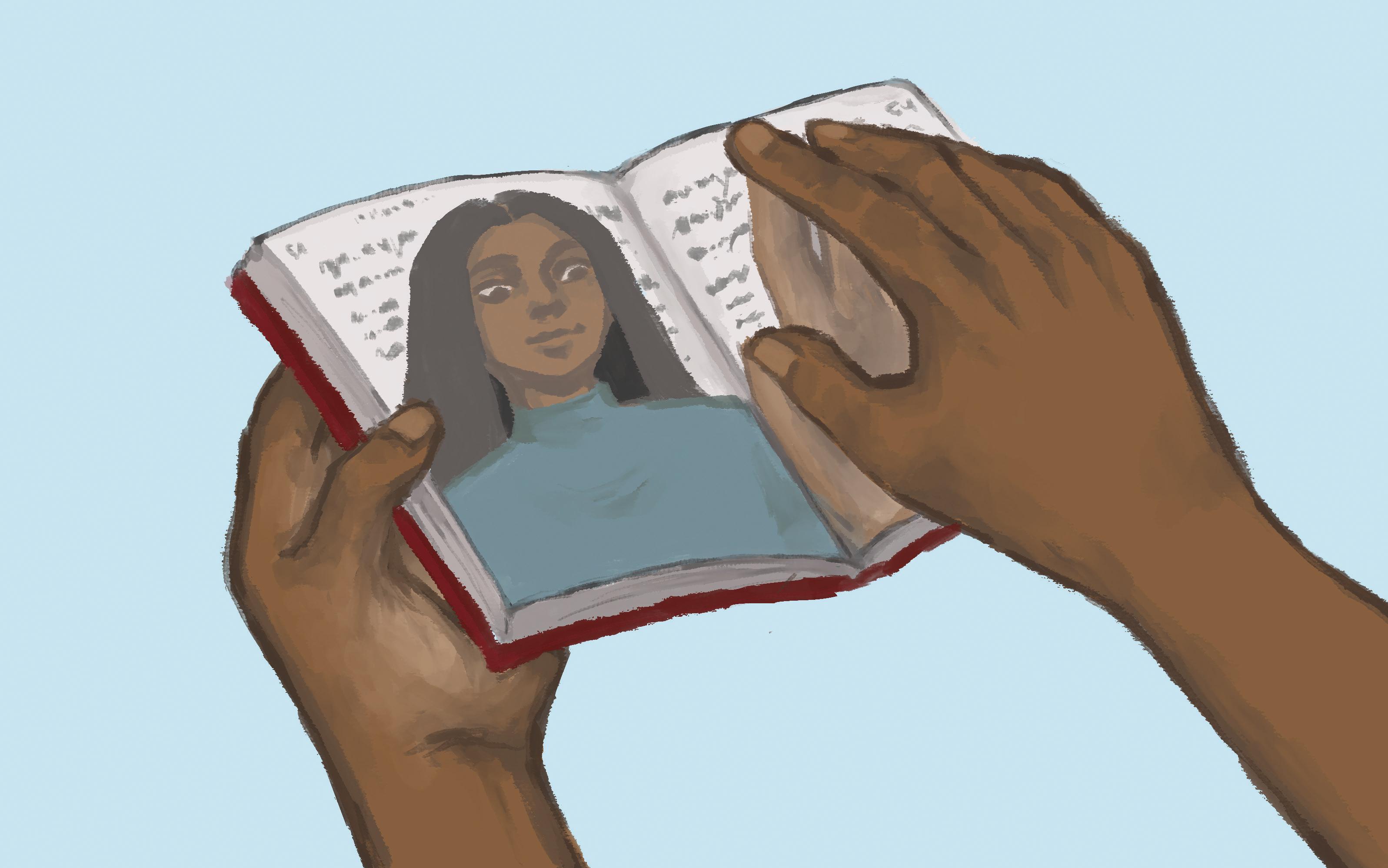
This was the case for Anguiano.
“When I read “The House on Mango Street,” I finally felt like I had a voice,” An guiano said.
Moments like these are essential for all students. Country Day must embrace a di verse curriculum to match its student body. To an extent, it does.
In the history department, both histo ry teachers Liz Leavy and Christopher Arns strive to highlight different cultures in their curriculum.
“I’m always looking for ways to plump up the non-European aspects of my curriculum,” Leavy said. “In fact, part of the reason I want to switch from Advanced Placement Art His tory to AT Art History next year is so we can further explore more diverse subjects.”
Similarly, the English department seeks to replicate the diversity of the student body into the book selections.
“In our English classes, we’ve really tried to have books from a wide variety of per spectives,” said Head of High School Brooke Wells. “All students have what we like to call windows and mirrors that reflect who they are and give insight into who other people might be.”
When it comes to gender diversity, the
school has succeeded.
“If you think about all of the classes you’ve taken, how many of them have a cast com posed entirely of female authors?” English teacher Diego Panasiti asked, referring to his English 10 curriculum.
Although Panasiti’s class is the only one to exclusively feature female authors, he is not alone in prioritizing gender diversity, a strength of the English department.
However, when it comes to diversity in terms of racial and sexual identity, there is some room for improvement.
Currently, the English 9 curriculum in cludes “Animal Farm,” “The Lord of the Flies,” “Warriors Don’t Cry,” “The Things They Car ried,” “The House on Mango Street” and “The Tempest.” Of that selection, two include Black or Latinx protagonists.
In English 10, sophomores explore immi gration with “Twilight: Los Angles, 1992,” “The Undocumented Americans,” “The Joy Luck Club” and “The Warmth of Other Suns,” which highlight Black, Latinx and East Asian voices.
However, in junior year, minority voices
voice for me” by Brynne Barnard-Bahn
are less prevalent with “The Marrow of Tra dition,” a book about the Black experience during the Wilmington Insurrection of 1898, being the sole source of representation in a list comprised of “A Midsummer Night’s Dream,” “My Àntonia,” “Ethan Frome,” “The Great Gatsby,” “The Maltese Falcon” and “Life Stories.”
Diversity returns senior year with “Ma Rainey’s Black Bottom,” “ Indecent” and “Hold These Truths’’ in English 12 and “The Laramie Project,” “There There,” “The Com plete Persepolis” and “Beloved” in AT English Literature. Together, the selection accounts for Black, Native American, Iranian, East Asian and LBTQ+ representation.
This is all great, but as Hinojosa said, “there is always room for improvement.”
Despite the school’s large South Asian population, none of the books in the high school are by or about South Asians.
To address this, the English department should consider adding “Interpreter of Mala dies” by Jhumpa Lahiri to the book list.
Suggested for ages 14 and up, the book is a collection of nine short stories highlighting
the struggles of Indians and Indian Ameri cans as they attempt to remember their roots while embracing a “New World.”
Additionally, although there is LGBTQ+ representation in the senior year curriculum, the school should consider replacing one of the books in one of the other curricula to bet ter represent its diverse student body.
Both “Orlando” by Virginia Woolf and “The Color Purple” by Alice Walker would be won derful additions to the school’s English cur riculum.
Only 134 pages, “Orlando” follows a trans gender poet’s journey with a satirical recount of the history of English literature, while “The Color Purple” documents the story of a Black teenager’s abuse and exploration of her sexual identity.
Both books discuss mature content, but in a classroom setting, students should be capa ble of safely exploring these themes.
And so, when the English department meets to discuss next year’s books, they should continue to implement the diversity that they have shown to value, constantly seeking to amend any shortcomings.
EDITORIAL: Add a greater variety of voices to the curriculum EDITORIAL: Hallelujah! Turning more holy days into holidays
Senior Karabelo Bowsky hastily finishes her math homework in her car, hoping to complete them before she has to attend the synagogue for Rosh Hashanah.
Bowsky, who is Jewish, struggles to balance religion and school. By fulfilling her religious and cultural commitments, Bowsky misses out on the chance to study for tests.
Bowsky is not alone in her struggle. The school’s calendar, which centers around Christian-based holidays, does not extend the benefit of scheduled days off to religious minorities.
An obvious example is winter break, the two-week break that always centers around Christmas, a Christian holiday, and New Years.
Country Day is a diverse and respectful community, but it should extend its values of diversity, equity, and inclusion to better accommodate different religious holidays for its student body.
Students are able to take the day off to at tend their holidays at the cost of an excused absence.
Although not damaging to their atten dance record, missing a day of school puts these students behind in terms of classwork and homework.
If Country Day transformed these holy
days into holidays, students would be able to enjoy their religious events to the fullest without sacrificing academics.
Junior Gulzar Sohal, a Sikh, supports the idea.
“A day off would be more useful because I wouldn’t have to worry about submitting homework the next day,” Sohal said. “Some people sacrifice religion due to school. School shouldn’t decide how you celebrate a reli gious holiday.”
Making space for holidays across different religions could help educate the community about varying religious practices and events.
Bowsky said the idea would work.
“I think it’d be really cool if we could make that a thing. You’d get the same opportuni ties as your classmates.”
Head of School Lee Thomsen said he un derstands the need to be respectful of the religious minorities within Country Day but notes some problems.
Thomsen said one-day breaks may disrupt workflow for students.
“It depends on how many days we’re taking away. If it’s two or three days, then it may be fine. But eight or nine days could lead to dis ruption. There’s a certain rhythm and consis tency to the schedule,” Thomsen said.
“I have a feeling that some people would
believe that would be great, but other peo ple may say, ‘Just when I was getting into the flow we took another break,’” he said.
Additionally, parents of lower and middle school students may struggle to find babysit ters for their children during the breaks.
Another issue is that some events, like Ramadan, celebrated by Muslims, including freshman Sammy MoheyEldin, are monthlong events, and it would be impossible for the school to accommodate it in its calendar.
However, the school could give a day off to an important day in Ramadan, such as Eid-alFitr, which marks the end of Ramadan.
One challenge the school may face is lu nar calendars or holy days that have varying dates.
Ramadan is based on the Islamic calendar, which is based on a lunar system.
MoheyEldin said this will not be an issue because lunar cycles can be predicted, and the school can adjust its calendar around that.
According to Thomsen, another obstacle is choosing which holy days to give one-day breaks for.
“Which faiths do we choose to represent?” Thomsen asked.
One method is asking the community what they believe in.
A Nov. 8 poll of Country Day’s high school student body found that 85% of 34 respon dents supported a school holiday to celebrate Rosh Hashanah, Yom Kippur, Eid-al-Fitr, Eidal-adha, Diwali and Gurpurab.
However, a disadvantage for students would be losing days in other breaks, such as summer vacation. Any day removed from the school calendar would have to be replaced, either in the beginning of the school year or the end.
Sohal said that adding holidays to the cal endar is worth starting school a few days ear lier.
“If it benefits religion or a person, it wouldn’t be too bad if we had an extra day of school. If it’s helping someone else, I think people could go through having an extra day of school. I think having a day break through out the school year would benefit everyone,” Sohal said.
Starting earlier would have another bene fit.
“I know AP teachers would love to start earlier in the year,” said Head of High School Brooke Wells.
So, the school should add six days to the beginning of the year to account for six days that would be lost to the celebration of reli gious holidays.
08 OPINION NOVEMBER 16, 2022 • THE OCTAGON
“A
MY ANGLE: Enjoy high school before it is over
BY GARMAN XU
The task was simple enough. “De scribe your classmates in three ad jectives and give a few anecdotes.”
However, sitting in the middle of the Senior Moratorium, listening to Clau dio Arrau’s rendition of Liszt’s Un Sospiro, I wasn’t expecting to be stumped by Ms. Perla’s Senior Adjectives and Anecdotes Form.
After all, I go to school with these peo ple every day. This should be easy, right?
But, as I grasped at all and any mem orable events that happened within the last few years, I quickly realized I did not have many.
A quarter into senior year, Thanksgiving season around the corner, I sit here and reflect on my time in high school.
It hit me that I was not the involved friend I originally thought I was. I realized I had missed out on fully enjoying my four years of high school with my friends. My overfocus on filling my schedule to the brim with rigorous courses during high school had left little time to go to sports games or just hang out after school.
As I went through the form, every ge neric adjective I ultimately put down stung as it reminded me of my regrets of not spending more time with my friends.
I am already applying to colleges, pre paring to move on from high school to the next stage of my life, but there are still so many things I haven’t done.
When I was in middle school, my friends and I would always stop by fast food places together, go bowling or even hang out at the park. My high school ex perience, however, has been lackluster in comparison.
Sure, I texted my friends online from time to time, but for the past four years, I had only gone out once to hang out with my friends outside of school events.
The thought had just drifted out of my mind after I became overloaded with work and expectations. The pandemic might have contributed to this issue as well, as it directly prevented hangouts from happening.
Nonetheless, I didn’t even realize how much I missed doing those things with my friends until it directly confronted me.
That’s why, after all this college appli cation madness is over, I made a promise to myself to take what I have left out this year and gain back what I have missed.
Believe me, I had always been open to going out with friends, but I realized the root of the problem was my mindset. I was used to waiting aimlessly for others to sug gest a hang-out.
Now, I understand that if you want to accomplish something, you have to pro actively decide on the specifics of how you are going to reach your goals with in this short four-year time frame. Your friends are just as busy — they’re just as likely to wait for you to set plans in motion.
Over the past month, I found success in making the extra effort to reconnect with my old middle school friends at the mall. Although we talked frequently through Discord voice chat, relearning our old secret handshake or giving the bros a hug strengthened my sense of belonging and reminded me of the importance of spending physical time with your friends and family.
Most of the time, the hardest step is committing to change; an old friend could be only a text message away.
At the same time, you should also be open to experimenting.
In addition to fun hang-outs, you can deepen your connection with your peers by working towards something you care about together.
One piece of advice I would give my freshman self is to try more things outside of the schedule set for you by CavNet and to follow your passion: this is the best time to experiment with what you enjoy, beyond the basics of school. Go have that epic laser tag game with your friends or start a club together.
My realization from the Senior Adjec tives and Anecdotes Form reignited my motivation to continue a club idea I have had in the works since last summer. With the help of friends, I plan to combine my involvement with art, design and business to create something memorable.
Although a large part of high school is made up of schoolwork and classes, there is more to the whole high-school ex perience than just pursuing an academi cally rigorous course load.
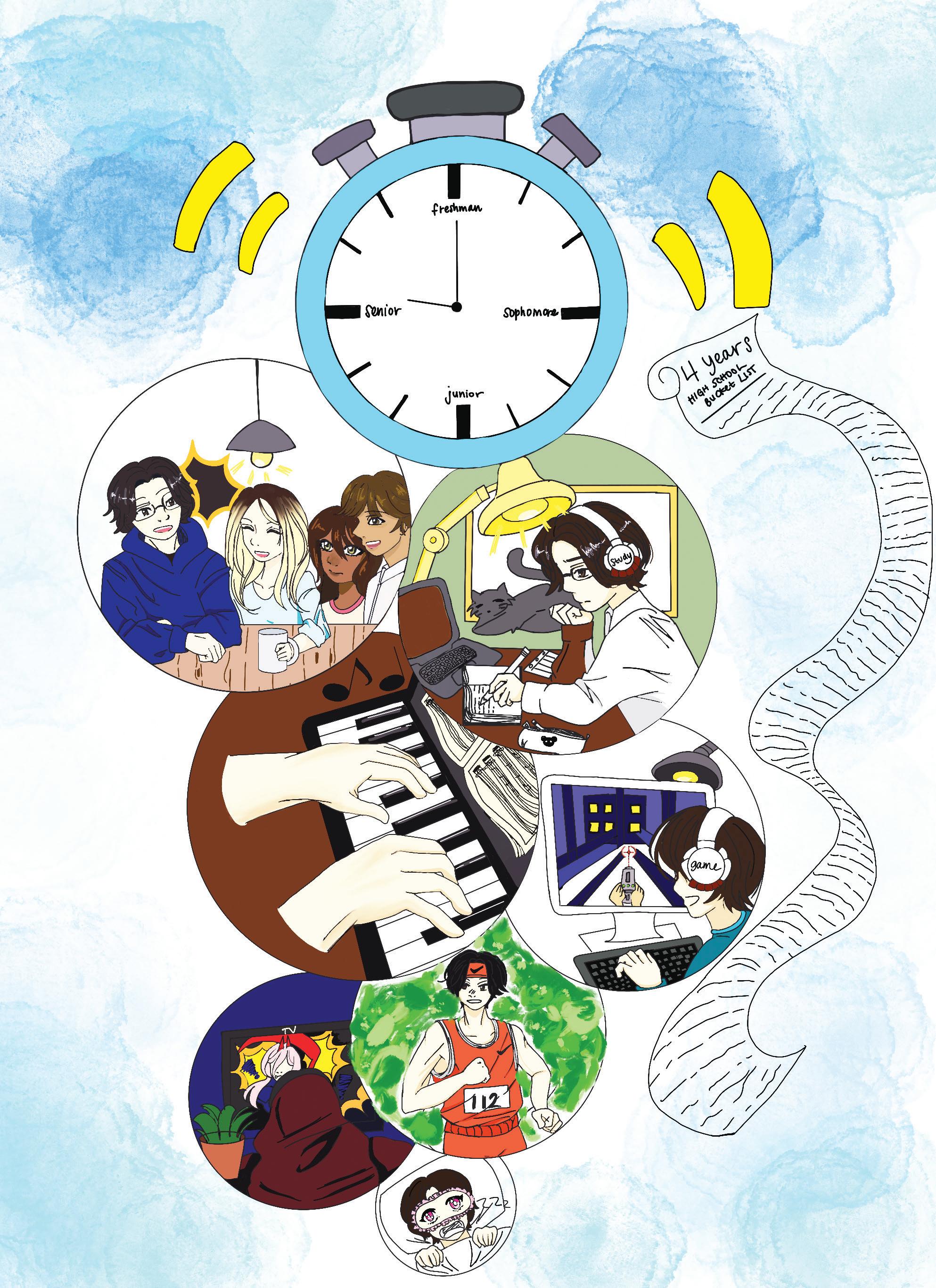
In other words, don’t just follow the path set for you by classes or extracurriculars. Instead, be more proactive in strengthen ing your relationships.
I’ve learned that it is never too late to start.
In fact, Thanksgiving is a great oppor
tunity for self-reflection, appreciation and readjusting goals for the future. Make sure to appreciate all aspects of the ex perience and make the most of what you want to accomplish before it all whizzes by in a flash.
MY ANGLE: How to save lives with your money
BY SAHEB GULATI
Most people try to do good in their lives. We sometimes help friends, maybe donate or vol unteer, or choose a career we think will help others.
But often we don’t really know what good we can do on a larg er scale. Are we really making a difference? How could we at tempt to do more?
By using evidence and rigor ous analysis to sort out what ac tions lead to outsized impact, we can ensure our time and money are used well and that people are helped and lives are saved.
There have been countless at tempts made by countless peo ple to create good in the world, but not all attempts turn out how they are intended. In fact, most of the things we do to help others aren’t as effective as we perceive, but the best attempts can be tremendously fruitful, ac complishing hundreds of times as much.
The key to separating the effective methods of “doing good” from the rest is critical thinking and careful research. By comparing methods as rigorous ly as possible and using data, we can better understand which in terventions are best.
Rigorous methods are import ant in determining how to do
good because our good in tentions, while a great starting point, are not often accurate.
In fact, a significant portion of social programs don’t fully ac complish their intended aims, according to 80,000 Hours.
We can examine a classic case study of a well-in tended solution gone wrong as an exam ple of a social endeavor that didn’t achieve its aims.
There’s a charity in op eration today called Play Pumps Interna tional. They install water pumps in rural African villages, with a twist: the pumps they install are built like mer ry-go-rounds, allowing children to simultane ously play and pump water.
To sweeten the deal, corpo rations can place ads on the pumps, generating additional revenue for villagers.
Sounds like an all-around great deal, right? Villagers get otherwise hard to access water, additional income streams and a diversion for children.
It seems that is what every one thought. People like the
First Lady Laura Bush and Jay-Z pledged support for the initia tive, which received millions in funding.
But eventually, the hype ceased when PBS’s Troubled Water documentary examined PlayPumps. It turned out, Play Pumps weren’t doing good at all. In reality, there were numerous lo gistical problems with the pumps. They produced less water and were more ex pensive than normal pumps, and children got quickly exhaust ed on a merry-goround that required constant force to keep spinning. Because no one had taken an evidentiary approach to analyz ing the impact of the pumps, much time and money went down the drain.
While cost-benefit analysis might poke holes in a lot of the charities funded today, we can use the powerful tools of critical reasoning to find the best oppor tunities that can yield orders of magnitude more impact — ev idence-based non-profits such as GiveWell, Founders Pledge
and Giving What We Can.
For example, Helen Keller In ternational, a charity recom mended by GiveWell, distrib utes Vitamin A pills to prevent deficiencies that lead to large reductions in child mortality in developing regions.
According to GiveWell, dis tribution of HKI’s Vitamin A pills could save a life for, on aver age, $4,500.
Clearly, there are interventions that reputably show outsized re sults compared to others.
So, what does this mean for the good we can personally ac complish?
First, let’s consider a hypo thetical scenario. Elijah, makes $180,000 and donates 10% of his income to HKI, the vitamin chari ty from earlier.
Elijah’s $18,000 donation could save over 4 lives a year.
Our simple analysis has led us to the conclusion that Elijah can save hundreds of people in his lifetime.
Imagine if one day, you were able to save a child from drown ing or getting killed. You’d feel like a hero!
A 10% income donation could be the equivalent of saving mul tiple times this many lives every year.
Ok, maybe we have some better ways to do good. Why should you get involved?
It turns out, there are a num ber of compelling reasons to try to do good with your time or money.
Sometimes we don’t realize it, but most of us are in extremely fortunate economic circum stances. According to Giving What We Can’s “How Rich Am I?” calculator, the median American’s income is in the top 4% globally.
Using a portion of this income to effectively help others would likely have minimal negative ef fects on our quality of life or this percentile ranking.
Actually, studies show that donating to help others could potentially have lasting positive effects for us.
Research conducted by the Harvard Business School supports this claim, finding that spending money for others promotes hap piness.
So, by combining evidence and compassion, our “effective altruism” can change the lives of many while making us happier.
It’s easy to feel like the world is on fire, and there are too many problems that are too large for us to make a difference. But our efforts can have an impact on very real lives, and shouldn’t be dissuaded.
With a little critical thinking and a lot of heart, we can try anyway.

OPINION 09 NOVEMBER 16, 2022 • THE OCTAGON
“The clock is ticking” by Lauren Lu
Chand’s Chicken CHeck-in
Close your eyes and think about your favorite comfort food. Now, open them, and if your answer did not involve your hands grasp ing a warm brioche bun, a juicy piece of chicken and an addictive, mouth-numbing spice, close them again and rethink your answer.
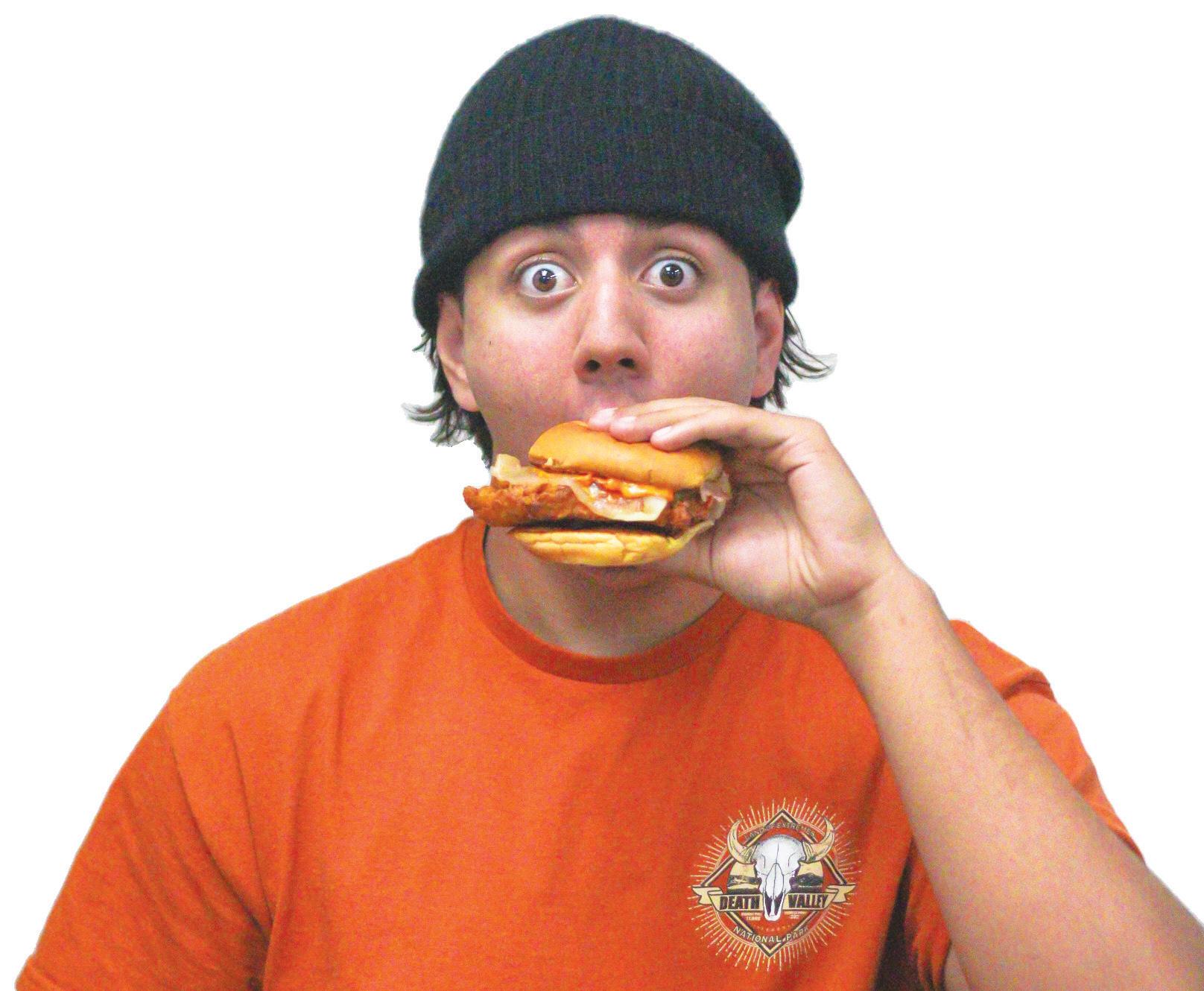
Out of the many items in the food world, nothing embraces a sense of balance like the spicy chicken sand wich. It’s a food that can simultane ously light your mouth on fire while cooling it off with a creamy signa ture sauce, deliver a crisp crunch and a soft baked dough — and be eaten in both the heat of the sum mer or the cold of the winter.
A ranking of restaurants pro ducing these bundles of pure deli ciousness are long overdue. Hence, Chand’s Chicken Check-in was con ceived to send one man in hopes of finding the best Nashville Spicy Chicken Sandwich.
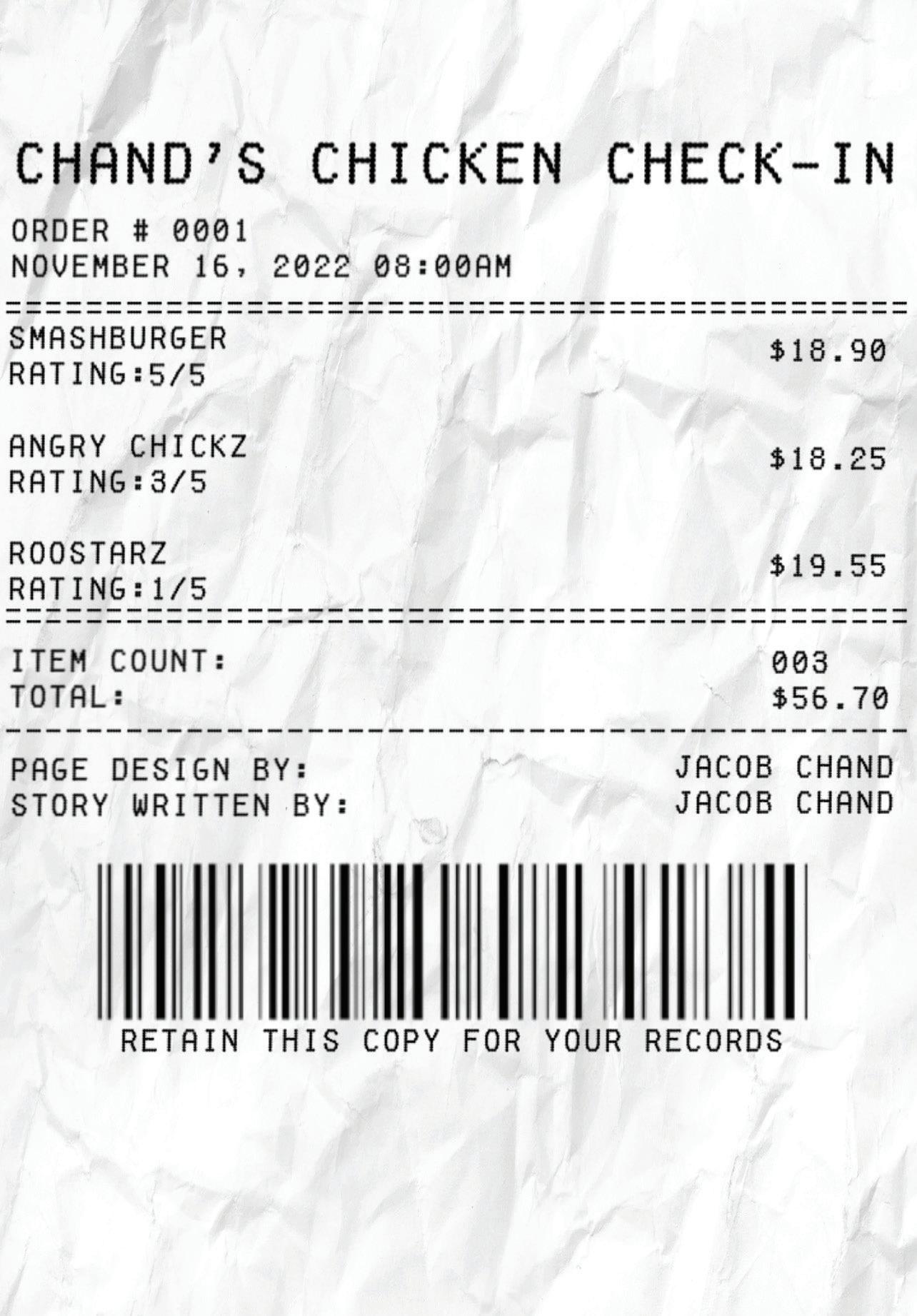
Without discussion and miles ahead of second place, Chand’s chicken champ is Smashburger, located in Loehmann’s Plaza, attaining the title of best Nashville hot chicken sandwich. Although known for cheeseburgers, the popular chain tried its luck, serving up this spicy food fad and beat expectations.

Smashburger lines can be long. Howev er, the joint is notorious for its extremely fast service, bringing me my sandwich in less than 6 minutes with around seven or ders in front of me.
With no elaborate presentation, the sandwich sits simply on a silver-grate tray with, in my case, a side of shoestring fries.
The most notable difference between Smashburger and others is its use of a chicken breast instead of a tenderloin.

In this case, the flatter and wider breast shape eliminates the annoying situation where you are eating only bun. Although the chicken is spicy, its balance between tongue-numbing spice and overall flavor is spot on.
This is mainly due to two factors.
First, Smashburger coats the chicken in a regular batter, fries it and then coats it in a spiced batter and fries it again for a perfectly balanced level of spice and crunch.
Secondly, Smashburger coats the burg er in a spiced oil, pushing in an extra lay er of kick and overall goodness. Put that chicken in between two great buns, a perfect sauce and an adequate number of pickles, and you can call that a close-toperfect Nashville Hot Chicken sandwich. Pick it up and he pillowy artisan bun


conforms to your hand, a perfect vessel to deliver the best bite you might ever experience. Additionally, the toasted bun keeps its structure to hold the signature Smash Sauce without getting soggy.
The sauce, although included in ev ery bite, doesn’t override the star of the show, the chicken, as its simplistic nature of mayonnaise, yellow mustard, dill pick le relish and lemon juice provide a taste ful punch.

With no contention, Smashburger flies its way over the other four Nashville chicken restaurants where I have eaten.
Heating up into third place, a local ly-loved chicken shack fell short of ex pectations.
Upon arrival, Angry Chickz on Sunrise Boulevard boasted a packed house on a Wednesday night. And
seemed understaffed. Once received, the hot chicken sandwich, contradictory to its title, was decently cold.
And to sum up the meal, just like its temperature, Angry Chickz displays the most decent use of 20 bucks a person can buy.
The sandwich is topped with an unbut tered-brioche bun that crumbles under even the slightest bit of pressure.
A basic bun is complemented by a bland sauce that I hypothesize to be just mayonnaise, ketchup and most likely a touch of garlic powder.
By far, the weakest component of An gry Chickz Sandwich is the chicken, or should I say, lack thereof.
It’s extremely hard to rank Angry Chickz chicken when it comes with a single slender tender — providing a series of fake-outs, where eyes are closed and you expect a mouth of hot chicken, but you’re met with nothing but a bun and a series of mediocre pickles and coleslaw. However, two things kept me from throwing Angry Chickz straight into last place: the chicken’s flavor and its side of

Angry Chickz chicken, al though small, packs a
punch! Its double-fried batter insured the chicken held together and incorporated intense heat throughout each bite.
The chicken, even though not breath taking, was not bad at all. The tender, cooked extremely well, melted in my mouth.
However, the fries were by far the best out of every restaurant on this list. Their crisp, flakey, well seasoned nature en capsulated a soft inside that acted as an intermediary between each mouthful of sandwich.
Firing its way into last place as not only the worst spicy chicken sandwich but the worst waste of time and money is with out contention, Roostarz. Although you should never visit their shop, Roostarz is located in El Dorado Hills with a shop emptier than my stomach after I ate the joke of a sandwich I ordered.

With no customers other than me, Roostarz took upwards of 20 minutes to produce my sandwich. Expectantly, I as sumed the sandwich had to be shipped in from Nashville itself! But if Nashville cooks up mushy buns, bland chicken and terrible sides, I think I’ll stick to Sacra mento.
Hoping for redemption, a bite into a stale bun shot down any hope. Upon first bite, I realized the mistake I made, and decided to just give the chicken a try. Flaking off the tender, the seeming ly plain, unspiced batter and chicken put the nail in the coffin. With no sauce to add the tiniest bit of flavor, Roostarz made me do the unthinkable, as my silver tray clanked along the trash bin, dump ing not only half of my sandwich but my hopes, dreams and money.
10 A&E NOVEMBER 16, 2022 • THE OCTAGON
Anti-Hero
Midnights Taylor Swift
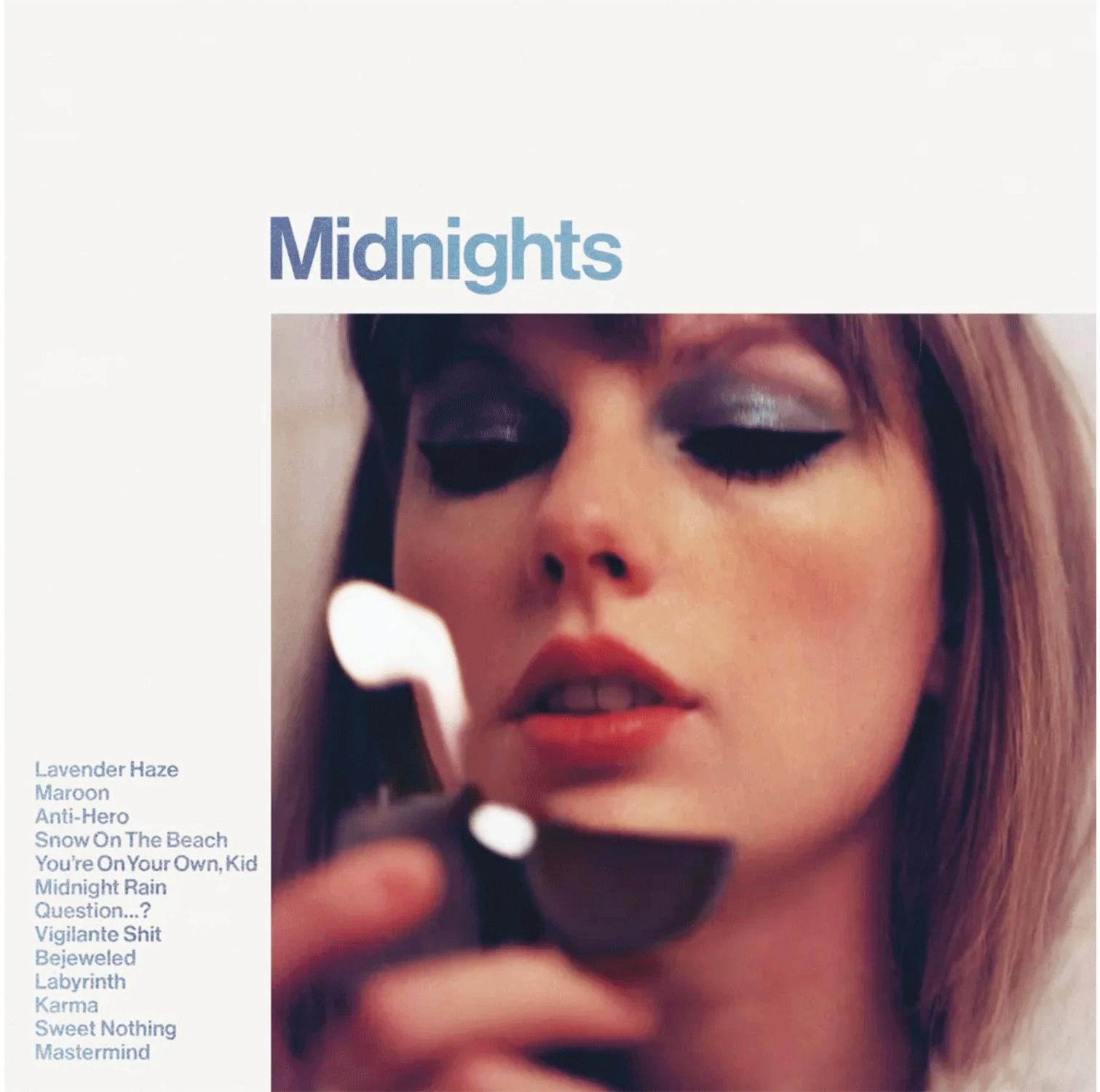



Pop · 2022
“
Midnights,” Taylor Swift’s newest studio album, has been lauded as both a critical and commercial success, shattering records since its release at midnight on Oct. 21. The original record contained 13 songs, and Swift dropped in seven more for the “3 a.m. version” to bring the total to 21. Here is a review of four popular tracks.

Shuffle Play
“Anti-Hero” feels surprisingly vulnerable for how upbeat it sounds.
Swift wastes no time in telling us what she thinks of herself at midnight — that her narcissism, her selfishness and her scheming are enough to drive anyone she loves away.
It’s convincingly told and painfully honest. She’s thirty-two — “a monster on the hill” — in an industry of teenage pop stars. Her faults are all-encom passing. She’ll “stare directly at the sun but never in the mirror.” Of course, “Anti-Hero” declares, Swift is the problem.
The music video, released on Oct. 22, echoes this mood. Nothing is as it should be: her breakfast eggs bleed a glittery purple yolk, she crashes a tea party as an Alice-in-Wonderland-esque giant, and she’s chased by her own ghosts, who are dressed in bedsheets and sunglasses.
The video’s most striking moment, though, is Swift’s own funeral. Her daughter-in-law, as the song speculates, has killed her for the money.
The video expands off this line into a two-minute scene where her chil dren complain about not being left in the will, blame each other for abus ing Swift’s legacy, and start a fight so large it derails the funeral .
I can understand what Swift was attempting to say here, at least, but it felt largely unnecessary. The loud, unpleasant shouting about shallow family relationships killed any subtlety in lyrics I was already ambivalent toward. Does she really dream of a nonexistent daughter-in-law, married to a child she doesn’t even have?
Nevertheless, I find myself forgiving “Anti-Hero.” In its rendering of intrusive thoughts, it’s beautifully successful.
Vigilante Sh*t
While “Vigilante Sh*t” promises intrigue, drama and revenge, we’re left with an empty shell of a track. I’ve never heard a song with less heart. In this song’s painful three-minute run, Swift:
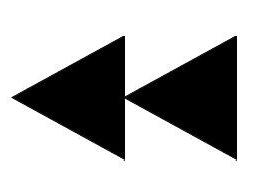
- Wears dramatic eyeliner.
- “Dresses for revenge,” presumably in addition to the eyeliner.
- Relies heavily on the clichéd “don’t get sad, get even.”

- Reports a man to the FBI for unspecified “white-collar crimes.” I don’t know about you, but working with federal authorities seems like the op posite of vigilante behavior to me.
“Vigilante Sh*t” is a hodgepodge, clumsy list. There’s no substantial ra tionale for this alleged vigilantism, and no emotion in Swift’s lyricism. You would think a song about someone “doing lines while he was crossing all of [hers]” would have some anger behind it. At the very least, you could expect some schadenfreude.













Instead, even the production drags. It’s an uninspired attempt at cap turing the dark electro-pop of Billie Eilish’s “bad guy” — a weak, repeti tive copy with no substance behind it.
It’s a song with absolutely nothing to say.
KarmaSwift tackles revenge anew in “Karma,” in a track I’m not sure how to feel about.
Swift, the song proclaims, has only lived a good life, so she’s now reaping the reward. The breeze in her hair, her cat, her boyfriend — that’s Taylor Swift’s karma. For those who have wronged her, though, they’re left “envi ous that for (them) it’s not” so simple.











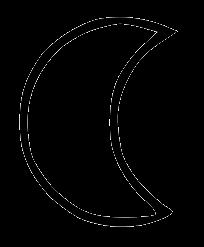
I came away unimpressed. The idea of karma has been discussed in Western pop culture ad nauseam, and often with more nuance and insight than what this song provides. Swift herself has done this before — she spent an entire album, “Reputation,” on the same beat, about the same people.
It’s not all bad, though. For all its faults, it’s carried by a catchy, upbeat tune. Its declaration that “karma is a cat” or “sweet like justice, karma is a queen” is made sincere by Swift’s voice, quietly delighted with her de served good fortune. If it wasn’t for my utter exhaustion with the lyrics, I would genuinely enjoy this song every time it played.
Unfortunately, though, nothing can save “Karma” from itself. It’s a thor oughly self-satisfied track, and its shallowness dilutes the joy of well-earned karma.
Would’ve, Could’ve, Should’ve
On my first listen, I was ambivalent about “Midnights” — large swaths of it felt too glossy for its concept of sleepless nights and too superficial for any real depth.
Then, the 3 a.m. tracks dropped, including “Would’ve, Could’ve, Should’ve.”
Once again, Swift has constructed a masterpiece of furious grief. Reminis cent of her hits “All Too Well” and “Dear John,” the song expertly explores a traumatic relationship that Swift wishes to forget.
Swift’s lyrics are achingly sincere and poignantly vicious. She “danced with the devil at 19” and asks if it mattered against the reputation of “a promising grown man.”
Her use of religious imagery is especially striking here, lending the song the desperation of a confession. Swift is trapped in the “stained glass window” of her mind, and in the “crisis of (her) faith” he has caused her.
The raw emotion in Swift’s voice is palpable. She knows she can never retrieve what was taken from her — her girlhood, her faith, her innocence — but she begs for it anyway. Even her delicate lyricism cannot shield the listener from the sheer scale of her horrified regret.
A&E 11 NOVEMBER 16, 2022 • THE OCTAGON
Anti-Hero Overall DOWNLOADED
REVIEW BY SAMHITA KUMAR; GRAPHICS BY AVA EBERHART; PHO TOS FROM SPOTIFY
What are you grateful for?
For some, Thanksgiving can be a time to reflect on the blessings of life, whether large or small, profound or ordinary. In the spirit of giving thanks, The Octagon asked students what they were grateful for in their lives.
INTERVIEWS BY EESHA DHAWAN; GRAPHICS BY SAMHITA KUMAR
“I know this is silly, but I am most grateful for my family. People do not realize how important blood is and how important having a good family and a supportive one is.”
—
Freshman
“I am grateful for my good health because I realize that not everyone is so lucky.”
— Junior Orlando Ponce Blas
Isaac Reynen
“I’m grateful for my cats, River and Nova, and my dog Tilly. They’re just like my friend group. We will just hang out and it’s just like a good vibe.”
— Senior Cecilia Wilson
“I am most grateful for my aunt. She’s the best person ever in my life because she’s the reason why I’m here. She’s the reason why I have good grades, all the things, and she inspires me so much because she’s a teacher, and she works really hard.”
—
“I am grateful for all the oppor tunities that I have in life because they will help me better my future and myself as a person.”
—
Freshman Itzel Zamora
“I am grateful for the “Lord of the Rings” series because it can always brighten my day.”
—
Senior Aaron
Monasa
Freshman Ferishta Halim
“I’m most grateful for my grandmother. She taught me math a lot when I was younger. She also spoiled me with a bunch of cookies, so naturally, I spent a lot of time with her and grew very close to her.”
—
Junior Ishaan Sekhon
“I’m most grateful for my voice because it’s my source of creativity and makes me the fun and happy person I am today. My powerful voice is motivational and confident and puts everyone around me in a good mood. It’s like a magic power only some people have.”
—
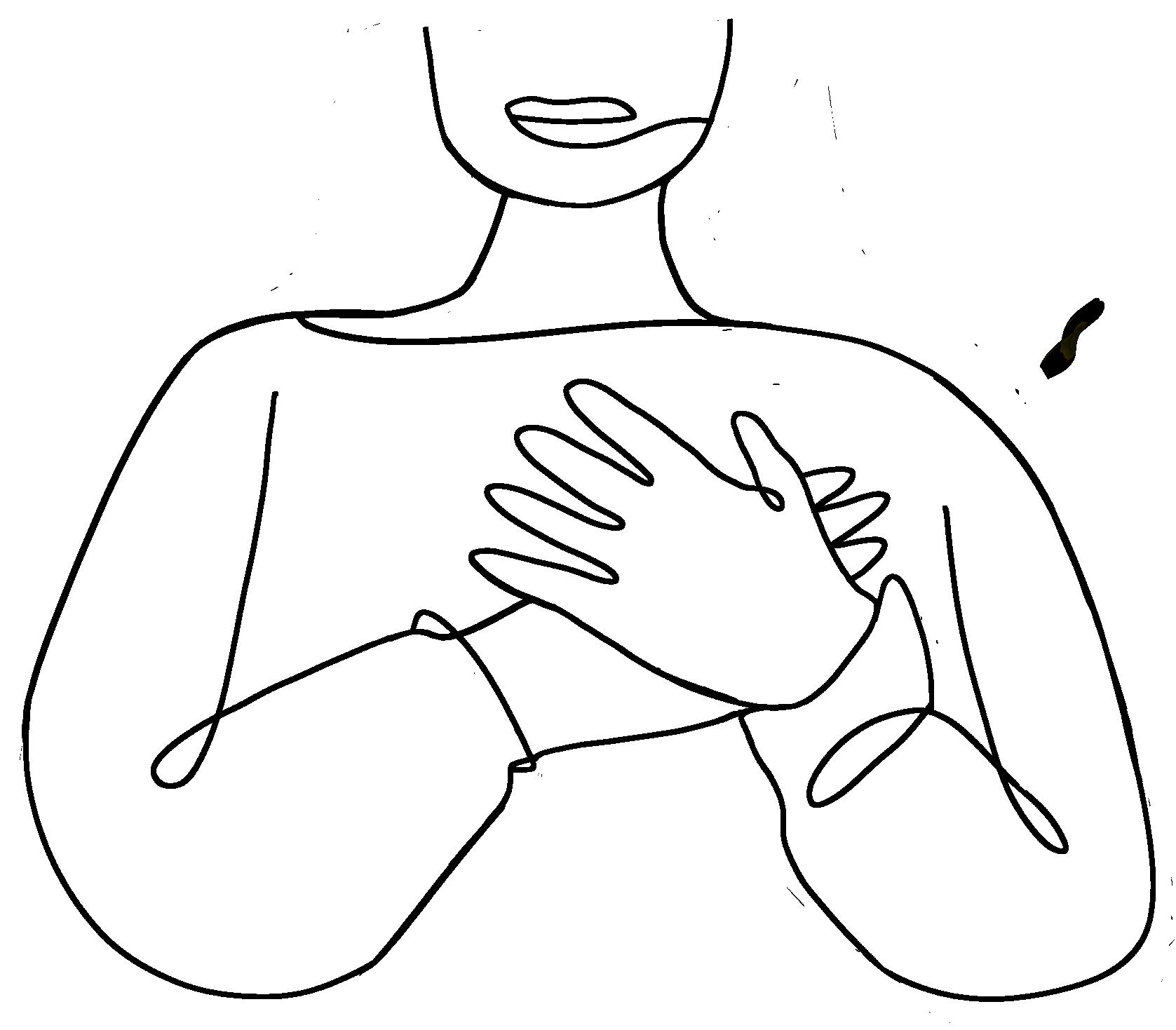 Freshman Ava Levermore
Freshman Ava Levermore
12 ENDPOINT NOVEMBER 16, 2022 • THE OCTAGON







 BY EESHA DHAWAN & SOPHIA MONASA
BY EESHA DHAWAN & SOPHIA MONASA







































 Freshman Ava Levermore
Freshman Ava Levermore